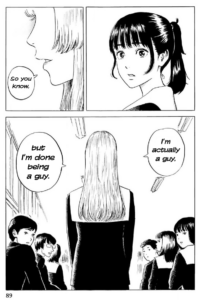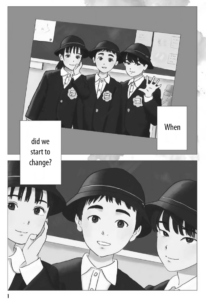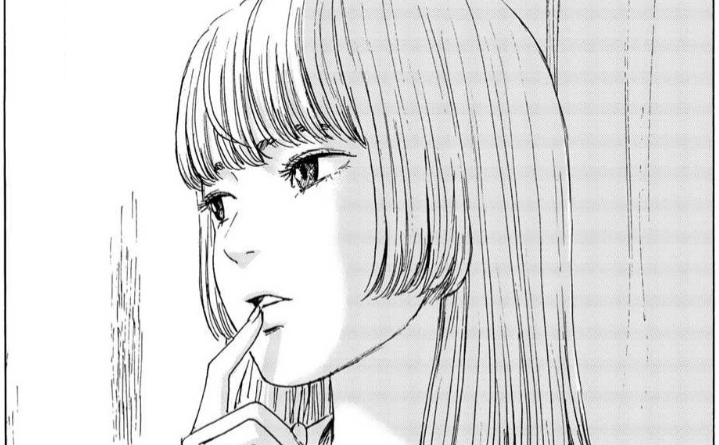Welcome Back, Identity Crisis
 Welcome Back, Alice is a disturbing, and at-times nauseating, mess, yet still remains effortlessly captivating in its twisted, vulgar beauty. It’s never gentle, rarely pretty, and revels in the abuses its characters inflict upon each other, but its unrelenting horror seldom feels gratuitous. It’s ugly, painfully so, but resolutely honest. The manga’s only ask, it seems, is for the reader to trust it’s going somewhere, though disastrous that place may be. It’s akin to asking its readers to step with it onto the Titanic, promising nothing but a pained embrace to fight the inevitable cold.
Welcome Back, Alice is a disturbing, and at-times nauseating, mess, yet still remains effortlessly captivating in its twisted, vulgar beauty. It’s never gentle, rarely pretty, and revels in the abuses its characters inflict upon each other, but its unrelenting horror seldom feels gratuitous. It’s ugly, painfully so, but resolutely honest. The manga’s only ask, it seems, is for the reader to trust it’s going somewhere, though disastrous that place may be. It’s akin to asking its readers to step with it onto the Titanic, promising nothing but a pained embrace to fight the inevitable cold.
Welcome Back, Alice is the most recent outing from renowned mangaka Oshimi Shūzō (押見修造), best known for works such as The Flowers of Evil, Happiness, and Inside Mari. Oshimi continues his previous works’ explorations of adolescence, identity, perversion, abuse, and sexuality, here, yet runs further and faster with them than any published piece of his to date. Unlike those previous stories, all tame in the face of Welcome Back, Alice by comparison, Oshimi centers his favored themes with no frills to mask them.
There are no vampires, sadistic, blackmailing classmates, or psychological thriller red-herrings to disguise what Oshimi seeks to explore. Welcome Back, Alice offers nothing beyond its three repugnant protagonists and shines a searing spotlight on them.
The story follows three childhood friends, Yohei, Kei, and Yui, who reunite with each other in high school. As children, a love triangle began to splinter the three, with Yui, the only girl, at its center. Yohei, who serves as the character the manga mostly follows, was in love with Yui, though she was in love with Kei. The fracturing group fell completely apart when Kei, without warning, moved away mere days after kissing and subsequently rejecting Yui.

When Yohei enters highschool, it’s already been years since he and Yui hung out together as close friends. As fate would have it, the two not only attend the same high school, but are in the same class. On their way in on their first day, Yohei encounters a gorgeous blonde woman who speaks vulgarly and overly familiarly with him. Following obscene gestures and intimate questioning, the blonde woman grabs Yohei and drags him into their shared classroom.
During roll call, the identity of the blonde woman is revealed to be Kei, who has given up “being a guy” and returned to school to reunite with Yohei.
The remainder of the manga explores the relationships between these three teens, confused in identity and sexuality, as they abuse and torment each other.
It’s messy, but it almost has to be.
From the mind of an author who has openly questioned his gender and identity in volume Afterwords since at least the early 2010s, it’s no wonder that Welcome Back, Alice’s default state is one of garbled confusion. Oshimi is perpetually disquieted by his sexuality and gendered place in the world – a fact he shares to nauseating detail throughout Welcome Back, Alice Afterwords – yet the conclusions he reports to reach are regressive, inconsistent, and steeped in unresolved baggage.

Welcome Back, Alice, by natural extension, serves as Oshimi’s most recent desperate attempt to explain himself as much as it serves as a fictional narrative. Though, how successful it actually is at either of those things is another matter entirely.
The story was recently completed, with the seventh and final volume being published in Japan on October 6th of last year. The official English release has, at time of writing, six of the seven volumes translated, with the sixth releasing in the US on March 19th.
Across its seven volumes, Welcome Back, Alice meanders its way through interpersonal conflict, seemingly content to follow the set-up chains of dominoes wherever they happen to fall. It reads less like a well-established, cohesively planned narrative, and more in line with a chaotic character study that evolves along with the author’s understanding of his characters.
The only consistent narrative throughline, should it even be able to be called as such, is the manga’s central question: “When did we start to change?” When did the characters stop being kids and start becoming women or men? When did society’s expectations of sexuality, objectification, and power truly start to take root? When did sexual or gender identity start to matter? Why did it start to matter?
The lack of overarching narrative planning beyond that central question is corroborated in Oshimi’s own words. The final Afterword of the series acknowledges the work as an effort at exploring themes of gender and sexuality that Oshimi himself has still yet to truly find his stances on; the author’s confusion and inconsistency are placed, by him, at center stage.

This meandering, unplanned nature hardly hinders Welcome Back, Alice when taken in holistically, though. Acknowledging the manga for what it is, an often-stumbling exploratory piece with no clearly defined answers, opens the reader up to appreciate the ugly authenticity with which these topics are explored in the first place.
Each character struggles with body image, lust, identity, and feeling like they have a place in the world or among their peers. Filled with resentment and absent a healthy outlet, they take it out on each other. Be it through manipulation, assault, shunning, or verbal provocation, each of the three protagonists is more than willing to fight dirty. None of them care if they all end up crashing, so long as it’s someone else that hits the ground first.
It’s often hard to read. Welcome Back, Alice strives endlessly toward its own readers’ discomfort, making near-constant aims toward the stomach-churning. Every volume and most chapters include some kind of abuse, outrageously explicit teenage sexuality, or some other display of depravity. The characters feel like real people, but selfish, pained, and at-times vile people.
It’d be easy to chalk Welcome Back, Alice’s presentation up as needlessly sensational, and any arguments to that effort wouldn’t be wrong inherently, but that would unfairly discount what it is the work is clearly trying to do. Coming of age fiction, especially in Japan, often errs heavily on the side of sterilizing youth. Works that display the way teenagers, especially those struggling with their gender or sexuality, actually act need to have a place at the table. That place doesn’t have to (and probably shouldn’t) be exclusively full of culture as vulgar as Welcome Back, Alice, but it’s sometimes through those extremes – the kind of which this manga presents – that authenticity is easiest to grasp.

By creating troubled characters only to imagine them at their absolute worst, the manga is hard to stomach at its most approachable. More questions on gender and sexuality are raised than are answered and Oshimi seems content to leave the work intentionally unsatisfying.
Still, in spite of its distressing and vulgar approach to storytelling, Welcome Back, Alice manages to stay optimistic. It imagines a world where people are awful to each other, but one where they eventually try to be better anyway. It hopes for a world free from oppressive gender norms and harmful misogyny, even if it doesn’t really believe such a world is possible.
After all, Welcome Back, Alice never answers its first and only consistent question. It doesn’t know – it can’t know – when we truly started to change.

